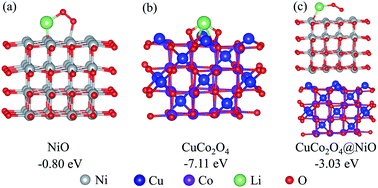Three-dimensional self-supported CuCo2O4 nanowires@NiO nanosheets core/shell arrays as an oxygen electrode catalyst for Li–O2 batteries†
Abstract
Developing rechargeable Li–O2 batteries is an effective way to relieve current energy stress and electricity shortage. Designing an oxygen electrode catalyst with superior bifunctional catalytic activity can significantly improve the performance of Li–O2 batteries. In this study, unique CuCo2O4 nanowires@NiO nanosheets core/shell arrays are directly synthesized on carbon cloth (CC) through a facile hydrothermal and electrochemical deposition. The one-dimensional CuCo2O4 nanowires have good electrical conductivity and a short transmission path to overcome sluggish kinetic processes. The two-dimensional NiO nanosheets can promote the easier formation and decomposition of Li2O2. The CuCo2O4@NiO/CC electrode can run 181 cycles with the capacity limit of 500 mA h g−1 at 0.2 mA cm−2, much higher than the CuCo2O4 electrode (107 cycles) and can exhibit the discharge capacity of 10 843 mA h g−1 at 0.1 mA cm−2, as well as better rate performance than CuCo2O4 electrode. Thus, the three-dimensional self-supported CuCo2O4 nanowires@NiO nanosheets core/shell arrays can take full advantage of each chemical component, provide more effective space for Li+ and O2 diffusion and Li2O2 storage, and possess better electrical conductivity.



 Please wait while we load your content...
Please wait while we load your content...